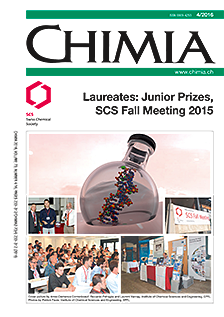Single-cell MALDI Tandem Mass Spectrometry: Unambiguous Assignment of Small Biomolecules from Single Chlamydomonas reinhardtii Cells
DOI:
https://doi.org/10.2533/chimia.2016.236Keywords:
Collision-induced-dissociation, Matrix-assisted laser-desorption/ionization, Single-cell mass spectrometry, Tandem mass spectrometryAbstract
The analysis of compounds from single cells is a major challenge in analytical life science. Labeling strategies, for instance fluorescence detection, are well established for measuring proteins with single cell sensitivity, but they mostly fail to detect small molecules. More recently mass spectrometry has entered the realm of single cell sensitivity and enables the label-free and highly parallelized detection of small biomolecules from single cells. The assignment of signals detected in single cells, however, generally has to rely on measurements in whole cell culture extracts. Isobaric structures, contaminations, higher noise levels and the high variability in the abundance of peaks between single cells complicate the assignment of peaks in single-cell spectra. Tandem mass spectrometry would be very useful for compound identification via mass spectrometry directly in single-cell analyses. Here we present the first single cell tandem mass spectra collected using matrix-assisted laser-desorption/ionization. The spectra obtained allow the assignment of most compounds detected in the spectra. We also show that the fragmentation is not restricted to the most abundant peaks in the spectra, but over a dynamic range of more than one order of magnitude.Downloads
Published
2016-04-27
Issue
Section
Scientific Articles
License
Copyright (c) 2016 Swiss Chemical Society

This work is licensed under a Creative Commons Attribution-NonCommercial 4.0 International License.
How to Cite
[1]
J. Krismer, R. F. Steinhoff, R. Zenobi, Chimia 2016, 70, 236, DOI: 10.2533/chimia.2016.236.







